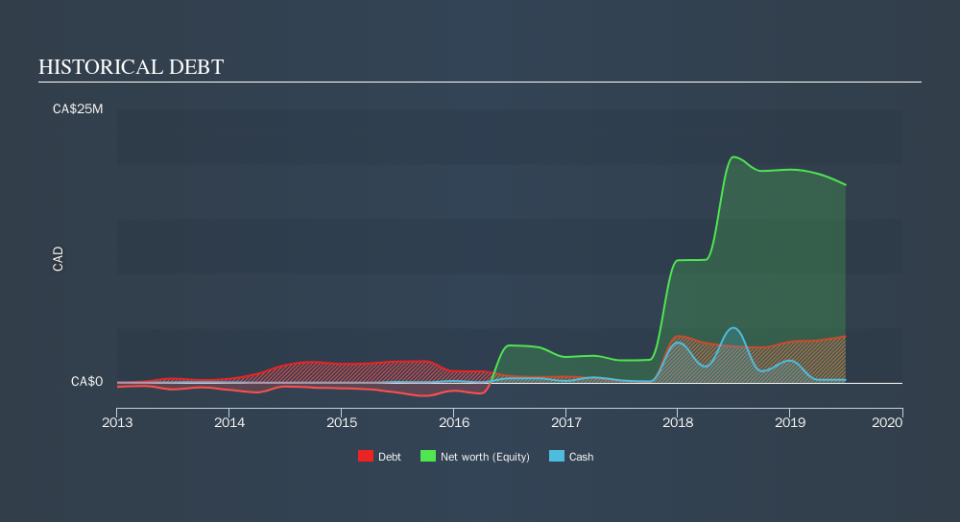Does Peak Positioning Technologies (CNSX:PKK) Have A Healthy Balance Sheet?

Some say volatility, rather than debt, is the best way to think about risk as an investor, but Warren Buffett famously said that 'Volatility is far from synonymous with risk. It's only natural to consider a company's balance sheet when you examine how risky it is, since debt is often involved when a business collapses. Importantly, Peak Positioning Technologies Inc. (CNSX:PKK) does carry debt. But should shareholders be worried about its use of debt?
What Risk Does Debt Bring?
Generally speaking, debt only becomes a real problem when a company can't easily pay it off, either by raising capital or with its own cash flow. Part and parcel of capitalism is the process of 'creative destruction' where failed businesses are mercilessly liquidated by their bankers. While that is not too common, we often do see indebted companies permanently diluting shareholders because lenders force them to raise capital at a distressed price. Of course, plenty of companies use debt to fund growth, without any negative consequences. When we examine debt levels, we first consider both cash and debt levels, together.
See our latest analysis for Peak Positioning Technologies
How Much Debt Does Peak Positioning Technologies Carry?
As you can see below, at the end of June 2019, Peak Positioning Technologies had CA$4.24m of debt, up from CA$3.32m a year ago. Click the image for more detail. However, because it has a cash reserve of CA$276.2k, its net debt is less, at about CA$3.97m.
How Healthy Is Peak Positioning Technologies's Balance Sheet?
The latest balance sheet data shows that Peak Positioning Technologies had liabilities of CA$8.55m due within a year, and liabilities of CA$651.2k falling due after that. On the other hand, it had cash of CA$276.2k and CA$12.7m worth of receivables due within a year. So it can boast CA$3.73m more liquid assets than total liabilities.
This short term liquidity is a sign that Peak Positioning Technologies could probably pay off its debt with ease, as its balance sheet is far from stretched. There's no doubt that we learn most about debt from the balance sheet. But it is Peak Positioning Technologies's earnings that will influence how the balance sheet holds up in the future. So when considering debt, it's definitely worth looking at the earnings trend. Click here for an interactive snapshot.
Over 12 months, Peak Positioning Technologies reported revenue of CA$4.3m, which is a gain of 1728%, although it did not report any earnings before interest and tax. When it comes to revenue growth, that's like nailing the game winning 3-pointer!
Caveat Emptor
While we can certainly savour Peak Positioning Technologies's tasty revenue growth, its negative earnings before interest and tax (EBIT) leaves a bitter aftertaste. To be specific the EBIT loss came in at CA$838k. On a more positive note, the company does have liquid assets, so it has a bit of time to improve its operations before the debt becomes an acute problem. Still, we'd be more encouraged to study the business in depth if it already had some free cash flow. Having said that the rate of revenue growth will likely impress the market, greatly facilitating any potential capital raising, if required. Despite that strong positive, this one could still be considered a bit too risky, by some. When we look at a riskier company, we like to check how their profits (or losses) are trending over time. Today, we're providing readers this interactive graph showing how Peak Positioning Technologies's profit, revenue, and operating cashflow have changed over the last few years.
If, after all that, you're more interested in a fast growing company with a rock-solid balance sheet, then check out our list of net cash growth stocks without delay.
We aim to bring you long-term focused research analysis driven by fundamental data. Note that our analysis may not factor in the latest price-sensitive company announcements or qualitative material.
If you spot an error that warrants correction, please contact the editor at editorial-team@simplywallst.com. This article by Simply Wall St is general in nature. It does not constitute a recommendation to buy or sell any stock, and does not take account of your objectives, or your financial situation. Simply Wall St has no position in the stocks mentioned. Thank you for reading.

